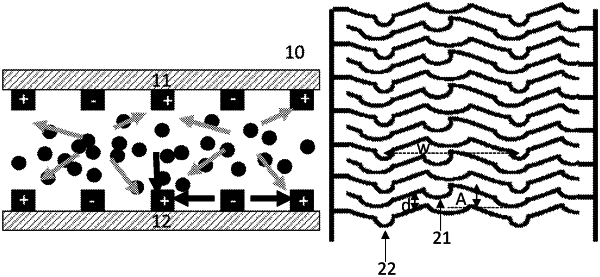| CPC G02F 1/167 (2013.01) [G02F 1/16755 (2019.01); G02F 1/1676 (2019.01); G02F 1/16761 (2019.01); G02F 1/1685 (2019.01); G02F 2001/1678 (2013.01)] | 37 Claims |

|
1. An optical modulator for electrophoretic switching between a transparent state and a non-transparent state and vice versa, the optical modulator comprising:
at least first and second substrates, wherein the first and second substrates are optically transparent,
four or more electrodes, wherein at least two electrodes are provided at an internal side of the first substrate, and at least two electrodes are provided at an internal side of the second substrate,
a fluid provided in between the substrates, the fluid comprising nanoparticles and/or microparticles, wherein the particles are electrically charged or chargeable, and wherein the particles are adapted to absorb and/or reflect light,
a connection for applying an electro-magnetic field to the electrodes, wherein the applied electro-magnetic field to the electrodes provides movement of the nano- and microparticles from a first electrode to a second electrode and vice versa,
wherein the at least four electrodes comprise an electrically conducting material with a resistivity of less than 100 nΩm at 273 K,
the at least two electrodes on the first substrate and the at least two electrodes on the second substrate electrodes are adapted to provide an electrical force between the electrodes in an orientation with respect to the substrates when switching to a non-transparent state or when switching to a transparent state, wherein the orientation is selected from parallel to the substrates, perpendicular to the substrates, diagonal with respect to the substrates, and combinations thereof,
a power provider in electrical connection with the at least four electrodes, wherein the power provider is adapted to provide a waveform power, wherein at least one of amplitude, frequency, and phase is adaptable, wherein the power provider is configured to switch the device to a transparent state through a first signal and to maintain the transparent state through a second signal, the second signal having a lower potential than the first signal.
|